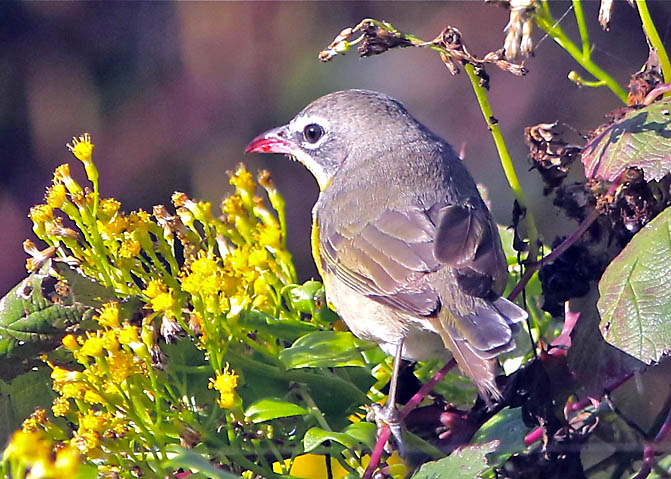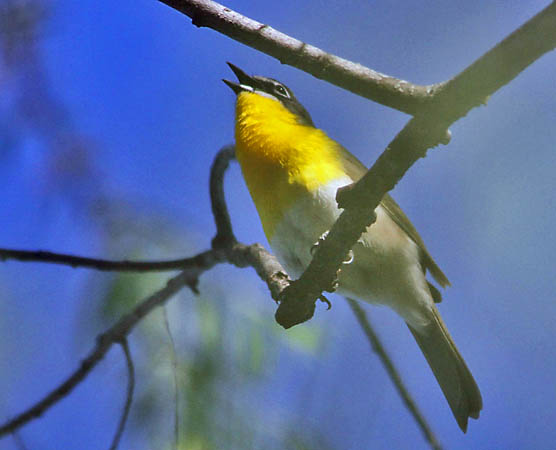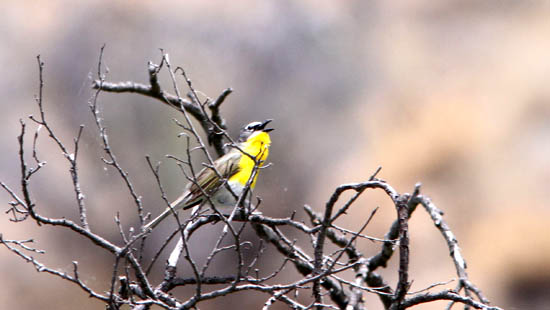
a web page by Don Roberson |
YELLOW-BREASTED CHAT Icteriidae |
|
This was primarily because the vocalizations of Yellow-breasted Chat — loud and mimicking — were entirely unlike any other warblers [photo, left, of a singing Yellow-breasted Chat]. Indeed, a recent Cornell website discussing this "warbler" described the "bizarre series of hoots, whistles, and clucks, coming from the briar tangles, [that] announce the presence of the Yellow-breasted Chat. This is our largest warbler, and surely the strangest as well, seeming to suggest a cross between a warbler and a mockingbird." Donna Dittmann is now the Collections Manager, Section of Genetic Resources, Louisiana State University, and 40 years later, it turns out she was right. Yellow-breasted Chat is not a parulid. It appears to be most closely allied to Icterids, but different enough that the AOU has just blessed it with full Family status on its own. [I see Dittmann's on-line citations at LSU include genetic work on thrashers, but apparently she didn't get the opportunity to work on the chat. But she was right anyway.] Barker et al. (2013) published an extensive analysis of the relationships of nine-primaried passerines (tanagers, New World warblers, sparrows, buntings, etc.) which found evidence that a few of the New World warblers had been misplaced within the phylogeny. For some of these, the authors proposed elevating them to their own Family, and one of those was the Yellow-breasted Chat Icteria virens. The evidence suggested that this Chat was clearly not a parulid but probably nearest to the Icteridae [New World Orioles, blackbirds and allies]. Some felt that more evidence was needed before creating the youngest bird family on earth, at a divergence age of about 10 million years ago (which, incidentally, is often used as a cut-off time for assigning Genus level divergence, not Family level; e.g. Cai et al. 2019 in Old World babblers). I resisted elevating the Chat to Family status in my 15th edition but now that the AOU, IOC, and Clements/eBird checklist have done so, as well as the newest book on bird families (Winkler et al. 2015), I am compelled to follow. World birders "need" to see a Yellow-breasted Chat if hoping to observe members of all bird families. Oddly enough, Barker et al. (2013) had to assign this Chat the formal Family name of Icteriidae, since the Icteridae (with just one "i" in the name) already exists! |
|
 Virtually
the entire population of Yellow-breasted Chat moves south to Mexico and
Central America in the winter. Records in winter from the United States
or Canada are very few, and there had never been one known to winter in
northern California until 2016. In November 2016, this hatch-year Yellow-breasted Chat
appeared in a willow thicket with some fruiting berry bushes at
Seaside, next to Monterey in Monterey County (my photo left). Male
chats have black lores so we thought this was a female at the time.
Note also that the bill is red from eating berries, and that the bird
is molting in its tail. This individual remained until 21 Apr 2017,
molting in black lores and "becoming" a male by the time it left,
having successfully wintered in the northern California. If that was
not astonishing enough, it returned and wintered again a second year [4
Nov 2017-16 Apr 2018], and then returned for a third year on 12 Oct
2018. It is still present for its third winter as I write this on
Christmas Day. Virtually
the entire population of Yellow-breasted Chat moves south to Mexico and
Central America in the winter. Records in winter from the United States
or Canada are very few, and there had never been one known to winter in
northern California until 2016. In November 2016, this hatch-year Yellow-breasted Chat
appeared in a willow thicket with some fruiting berry bushes at
Seaside, next to Monterey in Monterey County (my photo left). Male
chats have black lores so we thought this was a female at the time.
Note also that the bill is red from eating berries, and that the bird
is molting in its tail. This individual remained until 21 Apr 2017,
molting in black lores and "becoming" a male by the time it left,
having successfully wintered in the northern California. If that was
not astonishing enough, it returned and wintered again a second year [4
Nov 2017-16 Apr 2018], and then returned for a third year on 12 Oct
2018. It is still present for its third winter as I write this on
Christmas Day. |
Photos: The top Yellow-breasted Chat Icteria virens was singing at Lake Patagonia, Arizona, on 3 May 2015. The more distant singing male was along the Shasta River, north of Weed, California, on 22 June 2014. The wintering individual was at Laguna Grande Park, Seaside, Monterey Co., California, on 23 Nov 2016. All photos © Don Roberson; all rights reserved. Bibliographic note: There is no "family book" per se. The single species in this set have been previously covered in the applicable chapter on "warblers" in the Handbook of the Birds of the World series. Literature cited:
|
 A
short story: in the mid-1970s, some 40 years ago, I was actively
chasing throughout California looking for new State birds and Year
birds. I usually traveled with other San Francisco Bay area birders,
including many trips with a young Donna Dittmann. During one long drive
she told me that her dream for the future was to prove that
Yellow-breasted Chat was not a New World Warbler [family Parulidae] but
something else, maybe a thrasher? She was quite sure it could not be a
warbler.
A
short story: in the mid-1970s, some 40 years ago, I was actively
chasing throughout California looking for new State birds and Year
birds. I usually traveled with other San Francisco Bay area birders,
including many trips with a young Donna Dittmann. During one long drive
she told me that her dream for the future was to prove that
Yellow-breasted Chat was not a New World Warbler [family Parulidae] but
something else, maybe a thrasher? She was quite sure it could not be a
warbler.  Despite
its colorful appearance — adult males and females look pretty much
alike — Yellow-breasted Chat can often be elusive and hard to see in
the dense understory and riparian thickets that it prefers. It often
takes luck or patience to see a species that is comparatively
widespread across much of temperate North America. In the more arid
West, where I live, it is decidedly patchy and local, requiring
sufficiently thick and humid riparian thickets. Sometimes a Yellow-breasted Chat
will surprise the observer by unexpectedly signing from the top of a
tree, above the understory (right), and sometimes a male will launch
into the air to sing as it flies, with floppy wingbeats and dangling
legs, above the thickets.
Despite
its colorful appearance — adult males and females look pretty much
alike — Yellow-breasted Chat can often be elusive and hard to see in
the dense understory and riparian thickets that it prefers. It often
takes luck or patience to see a species that is comparatively
widespread across much of temperate North America. In the more arid
West, where I live, it is decidedly patchy and local, requiring
sufficiently thick and humid riparian thickets. Sometimes a Yellow-breasted Chat
will surprise the observer by unexpectedly signing from the top of a
tree, above the understory (right), and sometimes a male will launch
into the air to sing as it flies, with floppy wingbeats and dangling
legs, above the thickets.